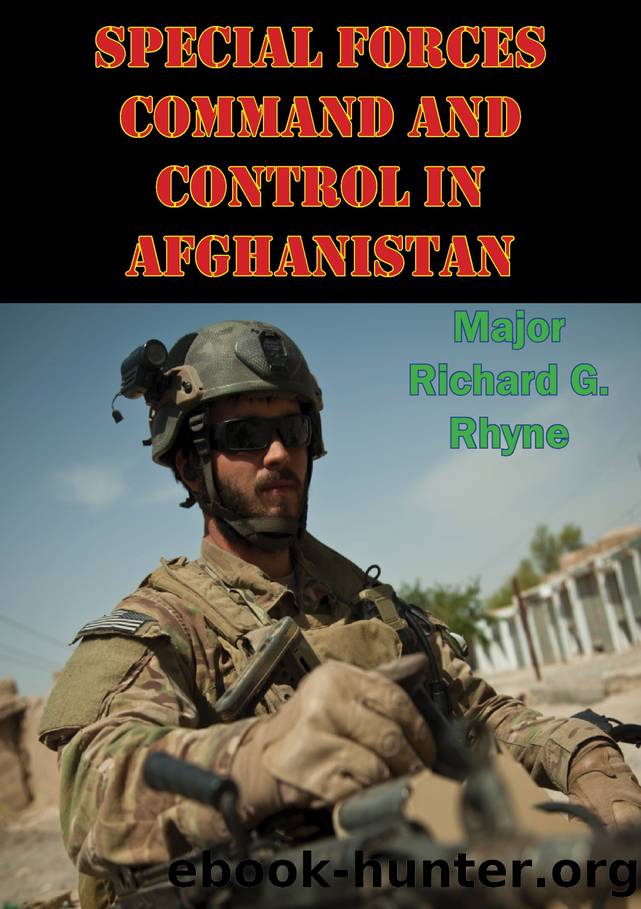Special Forces Command and Control In Afghanistan by Major Richard G. Rhyne

Author:Major Richard G. Rhyne
Language: eng
Format: epub
Publisher: Pickle Partners Publishing
Published: 2015-11-14T00:00:00+00:00
CHAPTER 4âAFGHANISTAN
On 15 September 2001, the United States Senate authorized the President of the United States to use whatever forces necessary to respond to those responsible for the terrorist attacks on 11 September 2001. During a news interview, Secretary of Defense Donald H. Rumsfeld pointed out some difficulties of determining targets in Afghanistan, requiring a different type of unconventional warfare, and the possible use of small elements of commandos (Schmitt 2001, 1). On 20 September 2001, the Army Special Forces Command from Fort Bragg, North Carolina, confirmed that they had received deployment orders, but would not reveal the number of forces involved. As the world watched and questioned the possibilities of retaliation, the Commander of Central Command requested Special Forces planners to look at different methods by which Special Forces elements could provide support to combat terrorists (Schmitt 2001, 1). On 7 October 2001, the President of the United States, George W. Bush, addressed the nation, âOn my orders the United States military has begun strikes against Al Qaeda terrorist training camps and military installations of the Taliban regime in Afghanistanâ (New York Times, 8 October 2001 excerpt on the presidentâs speech). By early October 2001, elements of the 5th Special Forces Group were deploying to Karshi Kanabad (K2), Uzbekistan. K2 would be the initial staging area for Special Forces elements for deployment into northern Afghanistan.
The initial stages of the war in Afghanistan were fought by integrated Special Forces and Air Force elements, which supported the Northern Alliance in defeating the Taliban and Al-Qaida. The Northern Alliance was a band of warlords in Afghanistan. Robin Moore, in his book The Hunt for Bin Laden, compares the Northern Alliance to the Montagnards of Vietnam. The Northern Alliance was Tajiks, Uzbeks, Hazaras, and other Dari-speaking tribes. They were considered the underdogs, and controlled only ten percent of the landmass of Afghanistan (Moore 2003, 17). The Al-Qaida was a mixture of fanatic Pakistanis, Chechens, Egyptians, and other Arabs who were not welcomed by the native Afghans. The Taliban was the ruling political party that espoused in the strictest beliefs of Islam. The Al-Qaida used the Talibanâs ideological fervor to support their holy war, âJihad.â Afghanistan had never been entirely controlled by a foreign power before. The British and the Russians both attempted, but failed to gain a strategic hold in Afghanistan.
Through the Northern Alliance, Special Forces with the assistance of the Air Force elements were able to gain a foothold in northern Afghanistan and drive the Taliban and Al-Qaida forces into the capital of Afghanistan (Kabul). It did not take long for the Special Forces and Northern Alliance forces to gain the advantage. The in-theater commander of Special Forces was the CENTCOM Combined Forces Special Operations Component Command (CFSOCC) led by RADM Albert M. Calland III. RADM Calland, special operations command CENTCOM (SOCCENT) commander, reported directly to GEN Tommy Franks, the CENTCOM Commander. RADM Calland established two joint special operation task forces (JSOTF), which separated north and south Afghanistan. The JSOTF in the
Download
This site does not store any files on its server. We only index and link to content provided by other sites. Please contact the content providers to delete copyright contents if any and email us, we'll remove relevant links or contents immediately.
| Civil War | Operation Desert Storm |
| Veterans | Vietnam War |
The Radium Girls by Kate Moore(11616)
100 Deadly Skills by Clint Emerson(4684)
The Templars by Dan Jones(4556)
Rise and Kill First by Ronen Bergman(4542)
The Doomsday Machine by Daniel Ellsberg(4241)
The Rape of Nanking by Iris Chang(4019)
Killing England by Bill O'Reilly(3896)
Hitler in Los Angeles by Steven J. Ross(3796)
Stalin by Stephen Kotkin(3722)
12 Strong by Doug Stanton(3418)
Hitler's Monsters by Eric Kurlander(3161)
Blood and Sand by Alex Von Tunzelmann(3055)
Darkest Hour by Anthony McCarten(3017)
The Code Book by Simon Singh(2854)
The Art of War Visualized by Jessica Hagy(2836)
Hitler's Flying Saucers: A Guide to German Flying Discs of the Second World War by Stevens Henry(2621)
Babylon's Ark by Lawrence Anthony(2427)
The Second World Wars by Victor Davis Hanson(2419)
Tobruk by Peter Fitzsimons(2373)
